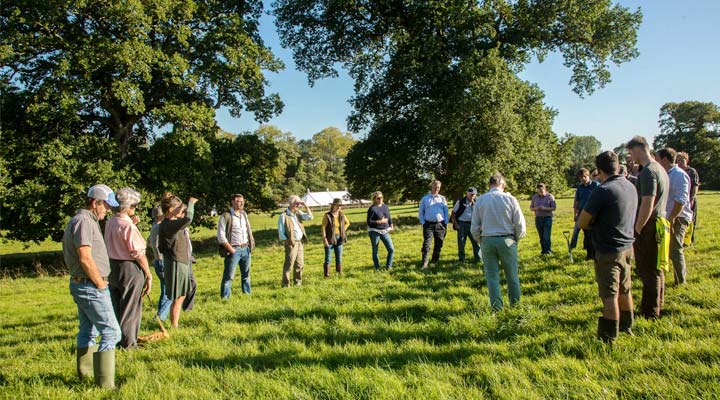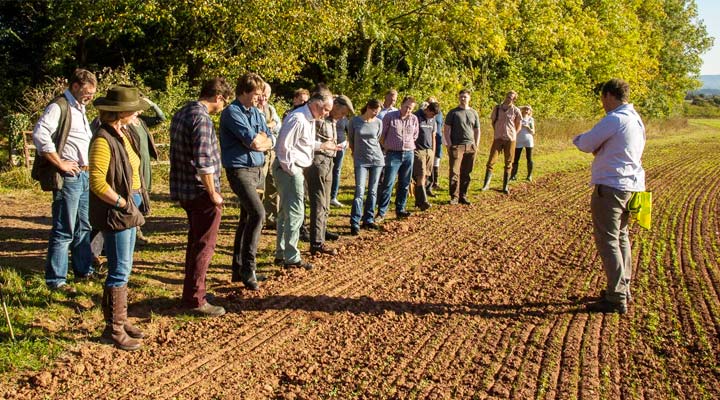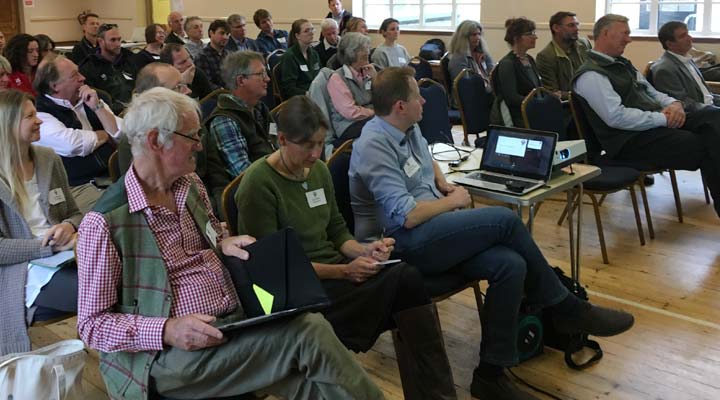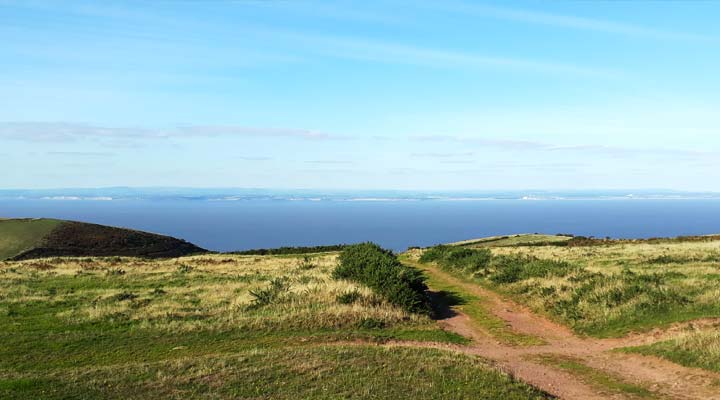PFLA AGM 2018 held on Exmoor

The 2018 PFLA AGM took place on Exmoor this year with two excellent farm walks, the formal AGM, updates from the team on the significant and exciting progress made over the past year and a keynote speech by Professor Dieter Helm, Chair of the Natural Capital Committee.
The event was held in conjunction with the PFLA Uplands group in Exmoor, which is being supported by the Princes Countryside Fund to see how the principles of pasture-fed farming can be used in SDAs (Severely Disadvantaged Areas) to improve farm profitability.
First farm visit
On the afternoon before the AGM, 20 or so delegates met at the Cothelstone Estate, home of PFLA member Hugh Warmington.
Situated on the southern slopes of the Quantock Hills not far from Taunton, this small traditional estate has been in the same family since 1792. Running from the deep red soils of Taunton Vale at 200ft to a heathland Site of Special Scientific Interest at 1,200 ft above sea level, with the steeper escarpment wooded, the farm was converted to organic production in 2008.
Hugh and Farm Manager, Paul Marks, gave a very thorough tour. A significant area is unimproved pasture, either too steep to plough or ancient parkland, with considerable landscape value. Indeed, the Quantock Hills was the first Area of Outstanding Natural Beauty to be designated in England.

Six hundred ewes are lambed outside in April from the back of a quad bike. The best are put to New Zealand Romney rams to breed replacements, with the remainder tupped by SuffTex. A few lambs will be drawn fat before weaning at the end of August, with most finishing off clover leys in the Autumn and over Christmas into the new year.
All lambs are sold privately to a butcher in Devon following a link via the PFLA, and finishing lambs into the new year helps to provide the butcher with year round supply.
There is a small herd of Aberdeen Angus suckler cows, calved indoors in February to April. After a summer at grass the cattle are housed in early November, in straw yards, and fed hay and a little silage. The calves are weaned after Christmas at about ten months old in the same building, causing minimal stress.
All ewes and the ewe lamb flock are outwintered on grass and green stubbles, with ring feeders of grass/clover silage as needed. The farm is part way through a move towards a paddock grazing system, which so far is proving worthwhile although Paul and Hugh noted there was a lot to learn and be fine tuned.

The AGM
The day of the AGM itself began with a welcome to the sixty or so delegates from Director Fidelity Weston and also from Katherine Williams of the Exmoor Hill Farming Network. The network is a farmer-led organisation bringing information, training, demonstrations, grants and opportunities to upland farmers across Exmoor. This independent network works in partnership with local farmers, agencies and the wider Exmoor community to provide a long term information and support ‘hub’ for Exmoor’s farming community.

Next on the agenda was a thanks to John Meadley, now PFLA President, for his tireless work for the Association from the beginning. While he stepped down as Chairman in 2017, this was the first opportunity to publicly extend the thanks of the Directors and members of the PFLA. This was done in an unusual but fitting way, in the form of a poem by PFLA Poet-in-Residence Adam Horowitz (read by Sara Gregson), aptly named “The Sheepdog”.
The formal part of the day, the AGM, included a presentation of the Annual Report and Annual Accounts by Russ Carrington.
Two Directors, Bill Wiggin and Dave Stanley (who had been previously co-opted onto the board) were formally elected and Russ also announced the board’s intention to co-opt Heather Jenkins, formerly head of agriculture at Waitrose, for a period of 12 months, to bring valuable expertise and experience onto the board. For a full list of PFLA directors click here.
Finally, Bill Wiggin gave thanks to retiring directors Anna Heaton and Jonty Brunyee, noting their significant contribution towards the development of the organisation.
Then it was the turn of the PFLA directors and staff to review a busy year for the Association, starting with Philippa Stagg, Membership and Office Manager. She updated the meeting on membership numbers (360) and the challenges in recruiting new members. She is working on improving the membership offering including working with companies who can offer discounts to members. Philippa’s final point was the importance of PFLA members themselves in promoting the work of the PFLA and the benefits of membership at every opportunity.
Anna Heaton, chair of the Certification Committee gave an overview on certification progress. She confirmed the arrangement with OF&G was working well and that the credibility of the Standards is essential hence a third party audit being required. The Dairy Standards were formally launched in January 2018 and there are now a small number of certified suppliers.

She urged members to consider becoming provisionally certified – this is done by internal checks to show the standards are being delivered. It would be very useful for the PFLA to know how many potential animals could be available.
The main Standards are being reviewed at the present time by the Certification Committee. There have been some direct proposals from members plus suggestions from the online forum. These are being considered. Once completed, the Standards will be circulated to the members and the Board for comment. The process should be completed by the end of 2018 and be brought into play in 2019. Anna finished by stating the Standards will never move from being 100% Pasture for Life.
Russ Carrington updated the meeting on supply chain developments. The survey with the membership in 2018 produced some interesting results, with some members having developed successful routes to market for their Pasture for Life products and others who were not yet selling into markets where their certified status was recognised.
He talked through the three categories of routes to market; Direct sales, Butchers working with farmer groups and large scale Wholesalers and supermarkets.
The interest to collaborate is certainly strong and he urged more members to become certified so that retailer interest can be linked up promptly when it does occur.
Sara Gregson presented the significant PR achievements from the year. There has been a wide range of coverage in farming press and there are a number of member recruitment-based articles being worked on.
Consumer publications have also been picking up on Pasture for Life and there has also been work done for and with stakeholder publications and with partner organisations.
Tasting events have been very successful and are a good way to promote the produce – being very useful to demonstrate through taste the importance of an animal’s diet. There are now also tasting guidelines for anyone who would like to organise their own event.
This year also saw a review of the use of the Pasture for Life logo as there was some confusion over what should be used. It was decided that the Certification Mark will be the only one to be used going forward.
Finally, Sara mentioned a new campaign around #grainfree. A communications plan has been drawn up but further funding will be required to deliver it.
Fidelity Weston talked through the work that has been done around policy and lobbying over the last 12 months. The suite of evidence papers is now complete; Why Grass-fed must mean 100% Grass-fed, The Health Benefits of Pasture for Life and The Animal Welfare and Environmental benefits of Pasture for Life.
She noted it is important to encourage change within government, ideally towards some kind of incentive for farmers to convert to Pasture for Life. Lobbying will continue on behalf of members.
Dave Stanley gave an update on research projects. As the PFLA has limited resources it was decided that the PFLA will only work on projects that completely align with what the Association is trying to achieve.
The SEEGSLIP project is evaluating the agronomic and social impacts of the Pasture for Life (PfL) certified approach to grazing management and its potential as the basis of a sustainable GB wide system. The first year’s activity has included surveying around 60 farms – putting certified farms into a wider context through measuring soil and vegetation on a typically managed field.
Next steps will be focusing on 15-20 farms and understanding the impacts of management practices on a range of soil qualities, identifying, with farmers, the most effective soil measures, talking to farmers around their motivations for being part of the PFLA and modelling potential broad scale impacts of extending practices to wider livestock farming.
Keynote speaker
The keynote speaker was Professor Dieter Helm, Chairman of the Natural Capital Committee, speaking on Natural Capital and Farming. Dieter spoke primarily from his own perspective and posed several questions for the audience to consider: What is natural capital? What is the 25 year plan and how does agriculture fit into it? What does “public money for public goods” mean? What would be the impact of the polluter pays principle and what does this mean for the PFLA?
Dieter provided plenty of food for thought and alluded to how we might see winners and losers as government support moves towards one that is based on natural capital and support for delivery of public goods. Increasing evidence of how Pasture for Life delivers public benefit was seen as good news for farmers taking the pasture-fed approach.

Farm walk no. 2
The final visit was to Wydon Farm near Minehead to hear from farmer Dave Knight who farms with his father and brother. Dave is Chairman of the Exmoor Hill Farming Network and gave the group of around 40 a tremendous tour of his farm which covers 1,400 acres, half of which is permanent pasture and half moorland.
There are 850 ewes and a 350 cattle suckler herd (half of which are outwintered on the moor with their calves). Ewes are lambed half in Feb and the rest in April in an attempt to catch the early markets. The aim is then to have all lambs sold (fat or stores) by the end of August to focus on getting ewes back into condition and having sufficient forage for the cattle.
This year has been particularly challenging due to the dry weather but one saving grace was the farm’s old ‘water meadow’ serviced by a stream from the hill which can be easily diverted to irrigate and fertilise parts of the pasture. Upon inspection this meadow also had a good depth of soil and a high organic matter component, which would have also helped with drought resilience and an early flush of spring grass.

Dave has begun experimenting with a paddock grazing system in an attempt to improve nutrition, but also improve resilience against drought. It is early days but he is happy to see some progress and is getting used to the electric fencing.
The breeding programme for cattle and sheep has been quite selective towards genetics which suit the landscape whilst also producing animals that the market requires. Beef breeds are predominantly Angus and Hereford. Whilst the Angus command a better premium, Dave prefers the Hereford for their docility, particularly for grazing moorland where there are many footpaths.
The farm tour took a spin onto the moorland with views of the Severn estuary. Dave explained the winter management and how the cattle love roaming the area and are quite happy without need for any supplementary feed – except in the harshest of weather conditions.




